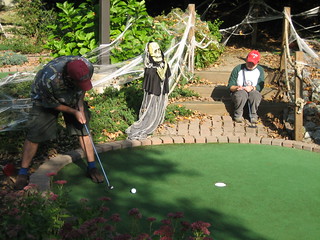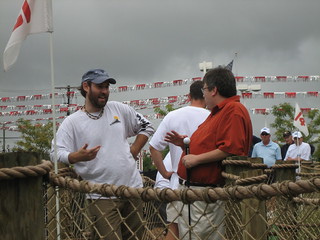Course Preparation
by Pat Sheridan on 04/29/15
Percentage of course preparation for this year's U.S. Open - 0% (only room for improvement!)
As I've mentioned
before, knowing the course is as important in minigolf as it is in a regular
golf. You'll easily save yourself one to
three shots per round if you know the break on your next putt or how to recover
if you get an unlucky bounce.

Knowing the break on this hole is the difference between a 2 on a tough hole and possibly a 4 or 5
The best way to know a course is to play it a lot. The second best way to know is a course is to friend someone who plays it a lot.
At most USPMGA tournaments I put myself at a disadvantage because I rarely have time to get there 2-3 days ahead of time to put in tons of practice rounds. When I arrive at the course I try to play one round by myself to get an initial feel for the course. I like to chart my own way as much as possible and feel a bit of pride when I figure out all the angles and breaks on my own. However, my pride has limits and I'm always willing to take tips and tricks from other players. One of the reasons we try to take pictures of all the holes on tournament courses is to give those players who can't make it to the course as early some idea of what they are in for when they arrive.

Pat and Gary discussing strategy at the 2008 Harris Cup Finals
This leads me to one of the best things about the minigolf circuit - everyone is very friendly and willing to share their strategies. It's often a hot topic during practice rounds. You hear a lot of "how do you play this shot?" and "I like to try this approach" chatter between players. While we are competitive, everyone wants to see their friends do well and in the end it always comes back to the ability to execute on those strategies. So there's really no harm in telling people that the best place to tee off is a club's head from the wall on a particular hole. That person still needs to hit the shot with the right speed, aim and luck to execute on that piece of advice.
Another important aspect to knowing the course is putting together a shot book. On the recent Bones episode around the death of a professional miniature golfer Agent Booth looks at the victims shot book and concludes it's some sort of secret code. He wasn't far from the truth. In most of the local tournaments I play, I don't really use a shot book because I've played those courses so many times I can tell you exactly what each hole does from memory. In addition, many of those course are skewed a bit towards ace shots, which means if you do miss your first, your second shot usually isn't very long or complicated. However, on courses like Bluegrass Miniature Golf, where the 2014 U.S. Open was played, and from what I hear about this year's course, you often find yourself having to make difficult and/or long deuce putts. This is where a shot book becomes invaluable. Last year I didn't so much have a shot book as I did a bunch of scraps of paper reminding me of a few key putts. This year I plan on doing a more in-depth book and mapping out all 18 holes, noting the most favorable tee positions, plotting the breaks to the hole and figuring out the most advantage moves for when I inevitably get myself into trouble. It will take a few hours of repetitive putting but it will certainly help come tournament time.
What it all boils down to is, before you walk onto the course for the first round, you should be at this level of conversation about the course (from The Simpsons "Dead Putting Society" episode):
Lisa: Eighth hole.
Bart: Aim
for the octopus's third tentacle.
Lisa:
Twelfth hole.
Bart: Bank
it off the pink tombstone.
Lisa:
Nirvana.
Bart: A
state of bliss attained through the extinction of the self.
Hopefully I'll reach my state of bliss before May 15th!

